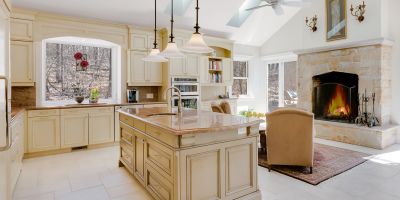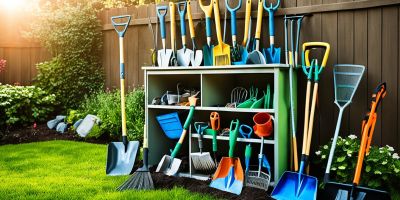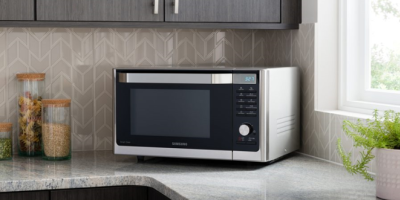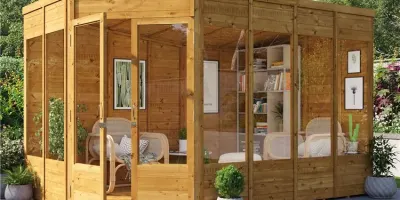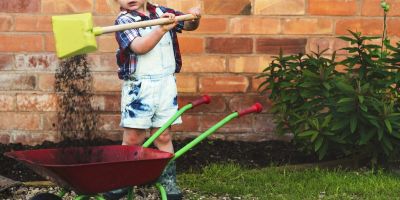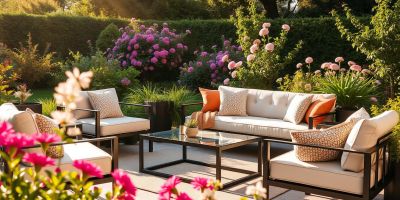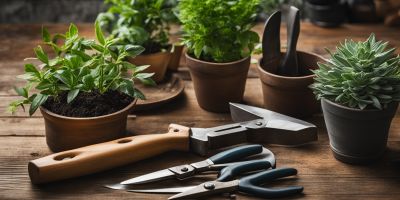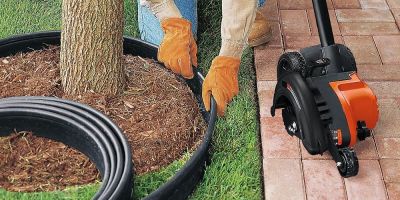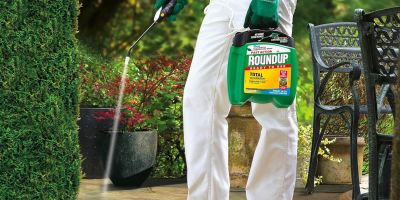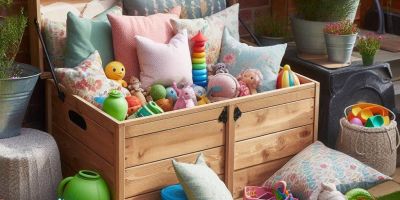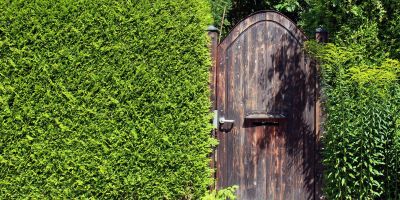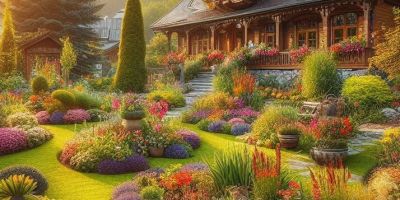2024-09-02 10:32:05 |
Garden sheds are more than just for storage. They can be the heart of your outdoor space, adding charm and versatility. They can store gardening tools, be a workspace, or a peaceful spot in your garden. You can match your shed to your home's style, choosing materials, colours, or designs that fit.
This way, your shed becomes a key part of your garden's look and feel. It can be a quaint farmhouse-style shed or a sleek modern one. Adding both beauty and function makes the perfect shed for your garden and needs.
Choosing the right shed boosts your garden's look and storage. You can pick from wooden sheds for their classic look and custom options, metal sheds for their strength and security, or plastic sheds for their easy upkeep and modern style. Most sheds come with free UK delivery and are easy to put together yourself.
This makes it simple to find the perfect shed for your outdoor area.
Key Takeaways
- Garden sheds enhance your backyard's storage and aesthetic appeal
- Various materials available: wooden, metal, and plastic sheds
- Free UK delivery typically included with garden shed purchases
- Sheds can serve multiple purposes such as workshops, offices, and retreats
- A shed's design can match your home’s architectural style
Understanding Your Garden Space and Needs
When planning for a new small shed or garden workshop, knowing your garden and needs is key. This knowledge helps with the design, type, and where to place the shed. Let's look at what you should think about.
Measuring Available Space
Start by measuring your garden space accurately. Sheds come in different sizes, so make sure to include space for insulation and cladding. Think about how easy it will be to get to the shed too. Some sheds, like Apex or Pent, need specific spaces for installation.
Using slow-growing pine from Northern Sweden, sheds last longer if measured right. It's important to get the measurements spot on.
Identifying the Purpose
What you want your shed for will shape its design and features. Whether it's for storage, a garden workshop, or a creative space, the purpose matters. Apex sheds are great for tall items, while Pent sheds fit well in gardens with lots of trees or near fences.
Reverse Apex sheds have doors on the long side, ideal for workshops. Think about what you'll use the shed for most to choose the right design.
Considering Future Use
Think about what you might need in the future when planning your shed. You might want more space later, so choose a spot that can grow with you. Pick shed types like overlap or shiplap for their strength and easy changes.
The floor type, like OSB or tongue and groove, is also crucial. It affects how strong and versatile your shed will be for different uses.
Adding a shed to your garden means balancing practical needs with looks. Measure your space, know what you need the shed for, and plan for the future. This way, you'll get a shed that fits well and meets your needs.
Choosing the Right Size for Your Garden Shed
Choosing the right garden shed is key. You must think about what you need now and what you might need later. The size of your garden also matters a lot.
Small Sheds for Limited Space
If you have a small garden, a small shed is perfect. Options like 3x5, 4x3, 5x3, and 6x3 are great for tight spaces. They hold your gardening tools and equipment without taking up too much room.
Keter sheds are a good choice for small gardens. They are strong, easy to look after, and you can put them together yourself. This makes your shed fit your garden just right.
Medium to Large Sheds for Greater Utility
Need more storage or a workshop? Look at a medium shed, like a 4x6, 5x7, or 7x7. These give you lots of room for things like lawnmowers and bikes.
For big storage needs, a large garden shed might be best. Sizes like 10x6, 6x10, 8x10, and 8x12 are good for lots of storage and space for DIY projects. It's wise to pick a bit bigger shed if you're not sure what you'll need.
Multi-functional Spaces
A shed that does many things can change your garden for the better. Keter sheds are great for this, fitting into different gardens while meeting various needs.
When picking a shed size, list and measure all your storage items. This way, you make sure your shed has enough room for everything now and later.
Exploring Different Shed Materials
Choosing the right material for your garden shed is key. You need to think about looks, strength, and how easy it is to keep clean. Wood, metal, and plastic each have their own benefits. Knowing these can help you pick the best one for your garden.
Wooden Sheds: Charm and Customisation
A wooden shed adds a classic look to your garden. They're often made from softwoods like pine or spruce. You can add special features like partitions or insulation to them.
Brands like Crane Garden Buildings use timber from Scandinavian Redwood. This ensures quality and helps the environment. Wooden sheds keep your space warm in winter and cool in summer.
Cedar sheds are great at fighting rot but are more expensive than pine sheds. On average, a wooden shed costs about £2,400. This makes them a great choice for a custom garden spot.
Metal Sheds: Durability and Security
A metal shed is known for its strength and security. They're made from steel or galvanised aluminium. These sheds are good against the weather and break-ins.
They're priced between low and medium, with an average cost of £750. Once set up, they need little upkeep, just a bit of oil for the hinges now and then. Metal sheds come with warranties against rust and holes, so they last a long time.
Plastic Sheds: Low Maintenance and Modern Design
If you want something easy to look after and modern, go for a plastic shed. They're made from vinyl and resist rot and bugs well. Cleaning them is simple, and they don't need much looking after.
Plastic sheds come in many styles and prices, from £400 to £5,000. They're light and might be hard to change, but they're a good deal and easy to set up. This makes them a favourite for many gardens.
Design Inspirations for Your Garden Shed
Finding the right design for your garden shed can make your outdoor area stand out. You might like the old-world feel of a cottage-style shed, the modern look of a contemporary shed, or the practicality of a greenhouse shed. Let's look at these inspiring options!
Cottage-style Sheds
A cottage garden shed adds a touch of vintage charm to your garden. They often have dormer windows, cupolas, and rustic wood finishes. Add floral window boxes, soft paint colours, and pretty garden paths to make it even more whimsical.
Modern and Minimalist Sheds
If you love clean lines and modern looks, consider a modern shed design. These sheds use materials like metal and glass for a sleek, urban feel. They come with flat roofs, big glass panels, and simple decor, fitting well in modern gardens. They're not just stylish but also useful, often serving as home offices or studios.
Greenhouse Sheds
Greenhouse sheds are great for gardeners. They offer space for plants and storage for gardening tools. With transparent walls, they let in lots of sunlight, perfect for growing plants. Add eco-friendly features like grass roofs or solar panels for a green touch.
Looking at these styles can help you pick a shed that suits your needs and garden look. Whether you want the charm of a cottage shed, the modern look of a contemporary shed, or the usefulness of a greenhouse shed, there's a great choice for every garden in the UK.

Incorporating Functional Features in Garden Sheds
Modern garden sheds are more than just for storage. They can have functional features for different uses. DIY enthusiasts can add workbenches to turn the shed into a workspace. Secure shelving helps keep tools in order, making the shed more useful.
For a shed that's welcoming all year, consider adding heating for winter and ventilation for summer. This makes it a great spot for hobbies or relaxing, no matter the weather. Customising your shed can make it perfect for an office, workshop, or retreat.
Lighting is key too. Big windows or skylights let in natural light, while good artificial lighting means you can use the shed at night. These features make your shed more useful and welcoming.
Don't forget about the floors and walls. Choose floors like insulated panels or vinyl for comfort and durability. Wall hooks, pegboards, and extra storage keep your shed neat and organised.
And think about the outside of your shed. Adding a porch or deck gives you more space and looks good with your garden. Pick paint and materials that match your garden. The right shed features can make your shed stylish and useful.
Best Practices for Shed Placement
Choosing the right spot for your shed is key for both use and lasting value. Picking an optimal shed location makes it more useful and keeps your garden looking good.
Choosing a Level Site
Always go for a level spot for your shed to make sure it stays stable and strong. If the ground is uneven, it can cause walls to warp and doors to fit badly. A flat area is best and helps avoid problems later. Make sure there's at least 50cm around the shed for easy upkeep and access. Check for any pipes or cables first to avoid any issues.
Considering Sunlight and Shade
Sunlight is important, especially if you plan to use your shed in summer or for storage. Too much sun can make things too hot, which is bad for some items. Having some shade is good for keeping things comfy and looking after your stuff. Luckily, British gardeners don't have to worry about big animals or extreme weather like in places like Alaska or Scandinavia.
Avoiding Overhanging Trees
Keep your shed away from trees and bushes that hang over to stop leaves and branches causing trouble. Leaves and sap can make the roof rot and cause damp. Rules say sheds over two and a half meters tall must be at least two metres from the fence to avoid legal problems.
Following these best practices for shed placement will make your shed last longer and fit well in your garden.
Maintenance Tips for Long-lasting Garden Sheds
Keeping your garden shed in top shape is crucial for its longevity. Regular upkeep can stop small problems from becoming big, saving you money and hassle. This way, your outdoor storage stays effective.
- Wash the exterior of the shed regularly to remove dirt and grime.
- Treat wooden sheds annually with a weather-resistant stain or paint.
- Repair any holes or cracks in the shed promptly to avert further damage.
- Inspect metal fittings for rust; tighten or replace components as necessary.
- Keep the shed base clear of debris to prevent rot and enhance longevity.
- Trim plants and branches near the shed to maintain air circulation and avoid moisture buildup.
- Secure windows and doors with strong locks to deter theft and ensure safety.
- Apply a fresh coat of paint or stain every 1-2 years to maintain the shed’s appearance and protection.
- Regularly clean the interior of the shed to avoid clutter and ensure an organised space.
- Install magnetic strips, pegboards, or hooks for efficient interior organisation.
- Ensure proper air circulation around the shed to prevent moisture accumulation and mould growth.
- Implement preventative maintenance practices to save on expensive repairs down the line.
Following these shed maintenance tips can greatly improve your garden shed's durability and look. Regular checks and quick fixes are vital. They help keep your shed strong and useful, making it a great addition to your backyard.

Creative Uses for Garden Sheds
Turning your garden shed into a space with many uses can change its role and increase your property's value. You can make it a garden workshop, a home office, or a place for hobbies. There are so many things you can do.
Garden Workshops
If you love gardening or DIY, your shed can become a workshop. It can have special storage and work areas. This makes it ideal for your gardening or projects. Adding shelves, tool racks, and a potting bench makes it look better and work better too.
Home Offices
With more people working from home, turning a shed into an office is a smart idea. It's a quiet spot away from the rest of the house. Adding a desk, chair, and good lighting can make it a great place to work.
Hobby Spaces
If you enjoy painting, music, or other hobbies, a shed can be your own special place. Keeping your things tidy and making it feel like your own can spark creativity. Many people find that a shed gives them the quiet they need to focus on their hobbies.
Garden sheds are not just for storage. They can be made into spaces that meet your specific needs. By thinking creatively, you can make your shed a valuable part of your home.
Aesthetic Enhancements for Your Garden Shed
Make your garden shed a reflection of your style with aesthetic enhancements. Whether it's for relaxing or working, these ideas will refresh your shed. Discover how to mix shed painting, decoration, and landscaping for a standout garden feature.
Painting and Staining
Painting and staining your shed protects it and adds colour. Pick a bright colour for visibility or a natural stain for garden blending. Use eco-friendly paints for a safe, eco-conscious space.
Decorative Elements
Decorative touches can change your shed's look. Think about adding window boxes with petunias or a Fleur De Lis Black Pull handle for elegance. Unique hardware and ironmongery add character, making it a garden highlight.
Landscaping Around the Shed
Landscaping around your shed is key for a welcoming feel. Use flower beds, stepping stones, or gravel paths to connect your shed to the garden. Choose easy-care plants and ground cover for a neat look. Solar lights can also improve your shed's look and usefulness at night.
For a beautiful garden shed, combine practical painting, creative decoration, and smart landscaping. This approach creates a space that's both useful and stylish, showing off your personal taste and garden needs.
Conclusion
Choosing the right garden shed is all about finding what fits your needs best. You might like the look of wooden sheds, the strength of metal ones, or the easy upkeep of plastic ones. The material you pick affects how well it works and how much care it needs. It's also key to think about the size you need, from a small storage spot to a big multipurpose area.
Garden sheds and summerhouses are getting more popular in the UK. They're not just for storing things. They can be used for workshops, hobbies, home offices, or even guest rooms. A well-designed shed boosts your property's use and adds beauty to your garden. Adding features like good airflow, insulation, and eco-friendly materials makes sure they last long and stay comfy all year.
Planning carefully leads to the perfect garden shed for your lifestyle. Every step, from the base to the look, is important for making the most of your shed. As you start this project, think about what you really need and like. This way, your shed will be a valued part of your garden for many years.
FAQ
What factors should I consider when selecting a garden shed?
When picking a garden shed, think about the space you have, its use (like storage or a workshop), and what you might need later. Also, consider the shed's material, design, and where it will go. This ensures it looks good and works well in your garden.
How do I measure the available space for a garden shed?
To measure the space, use a tape measure for the width, depth, and height of the spot for the shed. Don't forget to check for trees or fences and make sure there's enough room for the door and moving around the shed.
What are the benefits of different shed materials?
Wooden sheds are charming and can be customised. Metal sheds are strong and secure. Plastic sheds are easy to look after and have modern looks. Each type has its own benefits for different needs and tastes.
How do I decide on the right size for my shed?
The right size depends on your space and what you need it for. Small sheds are great for tight spots, while medium to large ones offer lots of storage or space to work. Choosing a shed that can grow with your activities is a good idea.
What design options are available for garden sheds?
There are many designs to choose from, like cottage-style sheds for a vintage look or modern sheds for a sleek feel. Greenhouse sheds are perfect for those who want to store plants and items in one place.
Can a garden shed be used as a workshop or hobby space?
Yes, garden sheds can be turned into workshops or hobby areas. You can add workbenches, shelves, and climate control. This turns them from just storage to useful workspaces.
Is it possible to install a shed myself?
Most garden sheds come with instructions and all you need to put them together yourself. It's a fun DIY project. But, if you prefer, you can get professional help for an easy setup.
Where should I place my garden shed?
Put your shed on a flat area, thinking about sunlight and shade for comfort and to protect the shed. Avoid putting it under trees to stop debris and damage. The right spot makes your shed useful and looks good.









